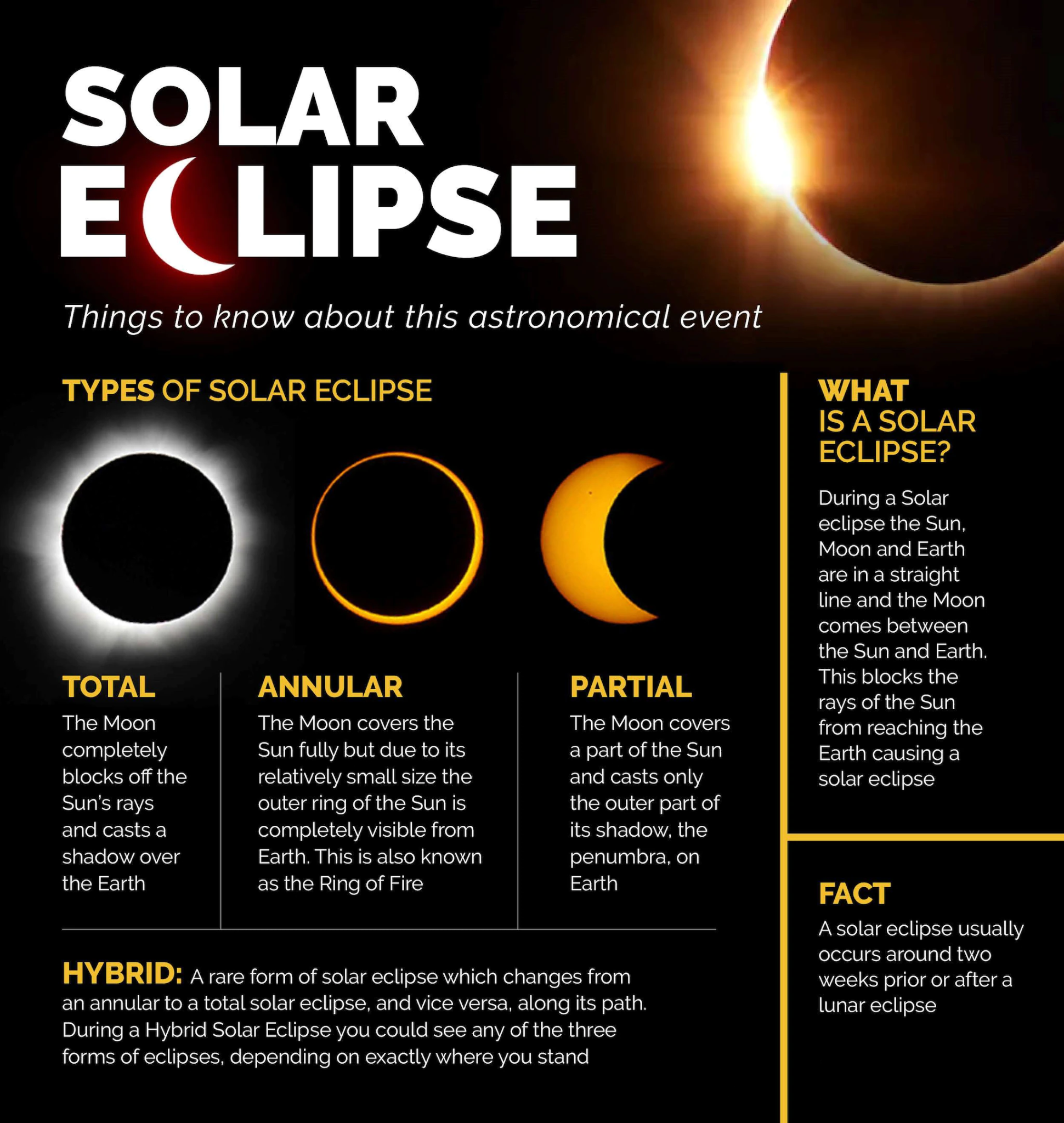Total Solar Eclipse | 08 Apr 2024
Why in News?
Recently, a total solar eclipse will cross North America, passing over Mexico, the United States, and Canada.
- Royal Museums Greenwich suggests that after a place on Earth experiences a total solar eclipse, it will take about 400 years before that spot sees another one.
What is a Solar Eclipse?
- About
- A solar eclipse takes place when the Moon moves in the middle of Earth and the Sun.
- The Moon blocks the light of the Sun, either fully or partially, which casts a huge shadow on some parts of the world. The areas in the centre of the Moon’s shadow at the time witnessed a total solar eclipse.
- The sky darkens and people who are in the path of a total solar eclipse can get a glimpse of the Sun’s corona.
- Types of Solar Eclipse:
- There are four different types of solar eclipses, including total solar eclipse, annual solar eclipse, partial solar eclipse, and hybrid solar eclipse.
- Total Solar Eclipse:
- A total solar eclipse occurs when the Moon passes directly between the Earth and the Sun, blocking out the Sun's entire disk from view.
- This creates a temporary darkness known as totality in the areas where the eclipse is visible.
- During a total solar eclipse, the Sun's corona, or outer atmosphere, becomes visible, along with bright stars and planets in the sky.
- It is a rare and often highly anticipated event.
- Annual Solar Eclipse:
- An annual solar eclipse, also known as an annular eclipse, happens when the Moon passes directly between the Earth and the Sun but does not completely cover the Sun's disk.
- Instead, a ring of sunlight remains visible around the edges of the Moon, creating a "ring of fire" effect.
- Unlike a total solar eclipse, the Sun is not completely obscured during an annular eclipse.
- These events occur when the Moon is near its farthest point from Earth in its elliptical orbit, causing it to appear smaller and not fully cover the Sun's disk.
- Partial Solar Eclipse:
- A partial solar eclipse occurs when the Moon partially obscures the Sun's disk as viewed from Earth.
- During a partial solar eclipse, only a portion of the Sun is blocked by the Moon.
- This creates a noticeable darkening or crescent shape on the Sun's disk, depending on the extent of the eclipse and the observer's location.
- Partial solar eclipses are more common than total or annular eclipses and can be observed from a wider geographical area.
- Hybrid Solar Eclipse:
- A hybrid solar eclipse, also known as an annular-total eclipse, is a rare type of eclipse that transitions between an annular and a total solar eclipse along its path.
- In certain sections of the eclipse path, the Moon's apparent size is not large enough to completely cover the Sun's disk, resulting in an annular eclipse. However, along other portions of the path, the Moon is closer to Earth, and its apparent size is large enough to fully cover the Sun's disk, leading to a total eclipse.
- As a result, observers situated along different parts of the eclipse path may experience either an annular or a total solar eclipse, while those positioned at specific locations along the path may witness a transition between the two types.
- Total Solar Eclipse:
- There are four different types of solar eclipses, including total solar eclipse, annual solar eclipse, partial solar eclipse, and hybrid solar eclipse.
How Frequently does a Solar Eclipse Occur?
- A solar eclipse is witnessed only during the new moon when the Moon and Sun are aligned on the same side of Earth.
- A new moon occurs about 29.5 days because that is how long it takes the Moon to orbit Earth.
- Solar eclipses typically happen only from two to five times per year. It is because the Moon does not orbit Earth in the same plane as the Earth orbits the Sun.
- The Moon is tilted by about five degrees with respect to Earth. As a result, most of the time when the Moon is in between the Sun and Earth, its shadow is either too high or too low to fall on the Earth.
Eclipse Magnitude:
- Eclipse magnitude is the fraction of the Sun’s diameter which is covered by the Moon.
- It is strictly a ratio of diameters and should not be confused with eclipse obscuration, which is a measure of the Sun’s surface area covered by the Moon.
- Eclipse magnitude may be expressed as either a percentage or a decimal fraction (e.g., 50% or 0.50).
- By convention, its value is given at the instant of the greatest eclipse.
UPSC Civil Services Examination Previous Year Question (PYQ)
Prelims
Q1. On 21st June, the Sun (2019)
(a) does not set below the horizon at the Arctic Circle
(b) does not set below the horizon at Antarctic Circle
(c) shines vertically overhead at noon on the Equator
(d) shines vertically overhead at the Tropic of Capricorn
Ans: (a)
- During ‘Summer Solstice’, on 21st June, the Northern Hemisphere witnesses its longest day of the year, while the Southern Hemisphere sees its shortest day.
- During this time, the Earth’s North Pole is at its maximum tilt towards the Sun and the Sun appears directly overhead at 23.5º north latitude, i.e. along the Tropic of Cancer.
- As the Arctic Circle falls in the Northern Hemisphere, the Sun does not set below the horizon during Summer Solstice, because here the sunrise and sunset start to converge in the northern sky. In contrast, the same event happens in the Antarctic Circle during Winter Solstice, 22nd December.
Therefore, option (a) is the correct answer.

